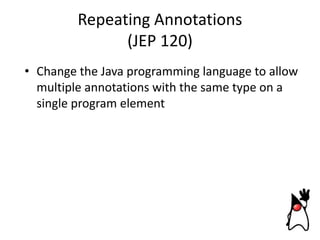Ad
New Features in JDK 8
- 1. New Features in JDK 8 Ivan St. Ivanov Dmitry Alexandrov Martin Toshev
- 2. Agenda • Lambda Expressions • Other New Features in JDK 8 • JEPs and JDK 9 Development
- 4. Lambdas • Lambdas bring anonymous function types in Java (JSR 335): (parameters) -> {body} • Example: (x,y) -> x + y
- 5. Lambdas • Lambdas bring anonymous function types in Java (parameters) -> {body} • Example: (x,y) -> x + y … well … Groovy (a superset of java) already provides this …
- 6. Lambdas • Lambdas can be used in place of functional interfaces (interfaces with just one method such as Runnable) • Example: new Thread(new Runnable() { @Override public void run() { System.out.println("It runs !"); } } ).start(); new Thread(() -> { System.out.println("It runs !"); } ).start();
- 7. Lambdas • Examples of such functional interfaces: java.lang.Runnable -> run() java.util.concurrent.Callable -> call() java.security.PrivilegedAction -> run() java.util.Comparator -> compare(T o1, T o2) java.awt.event.ActionListener -> actionPerformed (ActionEvent e) java.lang.Iterable -> forEach(Consumer<? super T> action)
- 8. Lambdas java.lang.Iterable -> forEach(Consumer<? super T> action) ?!? Isn't this breaking backward compatibility ?!?
- 9. Lambdas java.lang.Iterable -> forEach(Consumer<? super T> action) ?!? Isn't this breaking compatibility ?!? No - because forEach is an extension method.
- 10. Lambdas Extension methods provide a mechanism for extending an existing interface without breaking backward compatibility. public interface Iterable<T> { default void forEach(Consumer<? super T> action) { Objects.requireNonNull(action); for (T t : this) { action.accept(t); } } }
- 11. Lambdas • This essentially means that lambdas can be used to replace all functional interfaces used in a gazillion of libraries • Moreover lambdas increase performance when used instead of anonymous inner classes because they are implemented with the invokedynamic instruction • In this regard many of the standard JDK class are being refactored to use lambdas
- 12. Lambdas • Additional functional interfaces are provided by the java.util.function package for use by lambdas such as: o Predicate<T> - one method with param of type T and boolean return type o Consumer<T> - one method with param T and no return type o Function<T, R> - one method with param T and return type R o Supplier<T> - one method with no params and return type T
- 13. Stream API • Databases and other programming languages allow us to specify aggregate operations explicitly • The streams API provides this mechanism in the Java platform • The notion of streams is derived from functional programming languages
- 14. Stream API • The stream API makes use of lambdas and extension methods • Streams can be applied on collections, arrays, IO streams and generator functions
- 15. Stream API • Streams can be finite or infinite • Streams can apply intermediate functions on the data that produce another stream (e.g. map, reduce)
- 16. Stream API java.util.stream.Stream<T> collection.stream(); java.util.stream.Stream<T> collection.parallelStream(); Useful methods: o filter(Predicate), map(Function), reduce(BinaryOperator), collect() o sum(), min(), max(), count() o anyMatch(), allMatch(), forEach(),
- 17. Stream internals int sum = widgets.stream() .filter(w -> w.getColor() == RED) .mapToInt(w -> w.getWeight()) .sum(); • Stream operations are composed into a pipeline • Streams are lazy: computation is performed when the terminal operation is invoked
- 18. Method references • Intended to be used in lambda expressions, preventing unnecessary boilerplate • Example: books.stream().map(b -> b.getTitle()) books.stream().map(Book::getTitle) • Lambda parameter list and return type must match the signature of the method
- 19. Method references – static methods public class Printers { public static void print(String s) {...} } Arrays.asList("a", "b", "c").forEach(Printers::print)
- 20. Method references – instance methods (1) public class Document { public String getPageContent(int pageNumber) { return this.pages.get(pageNumber).getContent(); } } public static void printPages(Document doc, int[] pageNumbers) { Arrays.stream(pageNumbers) .map(doc::getPageContent) .forEach(Printers::print); }
- 21. Method references – instance methods (2) public class Document { public String getPageContent(int pageNumber) { return this.pages.get(pageNumber).getContent(); } } public static void printDocuments(List<Page> pages) { pages.stream() .map(Page::getContent) .forEach(Printers::print); }
- 22. Method references – constructors public static Stream<Page> createPagesFrom(Stream<String> contents) { return contents.map(Page::new). }
- 25. Lambdas Hands-on-Lab: Environment Setup • Download and install OpenJDK 8 early access build from https://jdk8.java.net/lambda/ (… or build yours from the OpenJDK repo)
- 26. Lambdas Hands-on-Lab: Environment Setup • Download and install an IDE: o Eclipse http://www.oracle.com/technetwork/articles/java/lambda1984522.html (for Eclipse 4.3: Start IDE -> Install New Software) http://build.eclipse.org/eclipse/builds/4P/siteDir/updates/4.3-Pbuilds o IntelliJ IDEA CE http://www.jetbrains.com/idea/free_java_ide.html
- 27. Lambdas Hands-on-Lab: Environment Setup • Get the sources: git clone https://github.com/AdoptOpenJDK/lambda-tutorial or download • Import the sources as Maven projects in the IDE http://dmitryalexandrov.net/lambda.zip • Set the Java 8 profile (source compatibility level) • Check if the sources compile and that you are able to run ConfigureYourLambdaBuildOfJdk
- 28. Lambdas Hands-on-Lab: Concept • We have several classes and tests for them • Find “// your code here” and write the code ! • Run the tests. Try to make them green! (… read the comments.. They are useful !)
- 29. Lambdas Hands-on-Lab: Task Categories • Internal vs External Iteration • Filtering and Collecting • Mapping • Method References
- 30. Lambdas Hands-on-Lab: Internal vs External Iteration Java 7 (External) for (Shape shape: myShapes) { shape.setColor(RED); } Java 8 (Internal) myShapes.forEach(shape -> shape.setColor(RED));
- 31. Lambdas Hands-on-Lab: Filtering and Collecting Java7 for (String s: otherThings) { if (satisfiesSomeCondition(s)) { things.add(s); } } Java8 otherThings.stream() .filter(s -> satisfiesSomeCondition(s)) .collect(Collectors.toList());
- 32. Lambdas Hands-on-Lab: Mapping Java7 List<String> upperCaseStrings = new ArrayList<>(); for (String s: mixedCaseStrings) { upperCaseStrings.add(s.toUpperCase()); } Java8 mixedCaseStrings.stream() .map(s -> s.toUpperCase()) .collect(Collectors.toList());
- 33. Lambdas Hands-on-Lab: Mapping Using a lambda expression: myStrings.map(s -> s.toUpperCase()); Using a method reference: myStrings.map(String::toUpperCase); Can be used with: • Static methods belonging to a particular class (<class>::<staticMethod>) • Instance methods bound to a particular object instance (<obj> :: <instanceMethod>) • Instance methods bound to a particular class (<class> :: <instanceMethod>) • Constructor belonging to a particular class (<class> :: new)
- 34. Lambdas Hands-on-Lab: Default Methods Java 8 public interface A { default void foo(){ System.out.println("Calling A.foo()"); } } public class Clazz implements A { } Clazz clazz = new Clazz(); clazz.foo(); // Calling A.foo()
- 35. Lambdas Hands-on-Lab: Default Methods Java 8 public class Clazz2 implements A { @Override public void foo(){ System.out.println("Calling A.foo()"); } } Clazz2 clazz2 = new Clazz2(); clazz2.foo(); // Calling A.foo()
- 36. Lambdas Hands-on-Lab: Let's have some fun
- 37. Lambdas Hands-on-Lab: Hints Examples: The basic syntax of a lambda is either (parameters) -> expression 1. (int x, int y) -> x + y or 2. (x, y) -> x - y (parameters) -> { statements; } 3. () -> 42 4. (String s) -> System.out.println(s) 5. x -> 2 * x 6. c -> { int s = c.size(); c.clear(); return s; } 7. myShapes.forEach(shape -> shape.setColor(RED)); 8. otherThings.stream().filter(s -> satisfiesSomeCondition(s)).collect(Collectors.toList()); 9. mixedCaseStrings.stream().map(s -> s.toUpperCase()).collect(Collectors.toList()); 10. myStrings.map(String::toUpperCase); 11. public interface A { default void foo(){ System.out.println("Calling A.foo()");} }
- 38. Other New Features in JDK 8
- 39. Date and Time API (JSR 310) • Provides a new date, time and calendar API for the Java SE platform • Examples: Clock clock = Clock.systemUTC(); ZoneId zone = ZoneId.systemDefault(); ZoneId customZone = ZoneId.of("Europe/Berlin"); Clock customClock = Clock.system(customZone); DateTimeFormatter formatter = DateTimeFormatter. ofPattern("MM-DD-YYYY"); LocalDate date = LocalDate.now(); String formattedDate = date.format(formatter); System.out.println(formattedDate);
- 40. Nashorn (via JSR 223) • Nashorn is a JavaScript engine developed in the Java language • A command line tool (jjs) for running javascript without using Java is also provided
- 41. Nashorn (via JSR 223) • Nashorn is a JavaScript engine developed in the Java language • A command line tool (jjs) for running javascript without using Java is also provided • … well … JDK 6 is already shipped with Mozilla's Rhino JavaScript engine but is slower …
- 42. Nashorn (via JSR 223) • Example (calling JavaScript from Java): ScriptEngineManager m = new ScriptEngineManager(); ScriptEngine nashorn = m.getEngineByName("nashorn"); try { nashorn.eval("print('Hello, world')"); } catch (ScriptException e) { }
- 43. Nashorn (via JSR 223) • Example (calling Java from JavaScript): var ExampleType = Java.type("com.sample.Example"); var example = new ExampleType("arg"); print(example.method())
- 44. Parameter Names (JEP 118) • Parameter names for method/constructor parameters can be retrieved at runtime via reflection Method method = … Parameter param = method.getParameters()[0]; System.out.println(param.getName());
- 45. Annotation on Java Types (JSR 308, JEP 104) • Extend the set of annotatable locations in the syntax of the Java programming language • Allow type checkers in the form of compiler plugins to provide stronger type checking • Sample annotations: @notnull, @readonly • Enhancements to JSR 269 (Pluggable Annotation Processing API)
- 46. Repeating Annotations (JEP 120) • Change the Java programming language to allow multiple annotations with the same type on a single program element
- 47. Base64 Encoding/Decoding (JEP 135) • Defines a standard API for Base64 encoding and decoding: java.util.Base64.Encoder java.util.Base64.Decoder
- 48. Concurrency Updates (JEP 155) • Scalable updatable variables (for frequent updates from multiple threads) are part of the concurrency updates: java.util.concurrent.atomic.DoubleAccumulator java.util.concurrent.atomic.DoubleAdder java.util.concurrent.atomic.LongAccumulator java.util.concurrent.atomic.LongAdder
- 49. Compact Profiles (JEP 161) • Defines a few subset Profiles of the Java SE Platform Specification so that applications that do not require the entire Platform can be deployed and run on small devices. • Currently three profiles: o compact1 o compact2 o compact3
- 50. Other • Prepare for modularization (JEP 162) - changes and deprecation of APIs to prepare for the modularization of the platform as undertaken by project Jigsaw • Permanent generation space removed - objects from this space such as class metadata, static variables and interned strings moved to heap space (improved convergence between OpenJDK and Oracle's JRockit)
- 51. Some books
- 52. JEPs and JDK 9 Development
- 53. JEPs and JDK 9 Development So lets see what JEPs are left for JDK 9 -> http://openjdk.java.net/jeps/
- 54. Q&A
- 55. References OpenJDK 8 early access builds https://jdk8.java.net/ Oracle JDK 8 early access builds http://www.oracle.com/technetwork/java/javase/d ownloads/ea-jsp-142245.html Eclipse with JDK 8 support https://wiki.eclipse.org/JDT_Core/Java8
- 56. References OpenJDK mercurial repositories http://hg.openjdk.java.net/ OpenJDK 9 build instructions http://hg.openjdk.java.net/jdk9/jdk9/rawfile/tip/README-builds.html JSR 337: Java SE 8 (Early Draft Review Specification) http://cr.openjdk.java.net/~mr/se/8/java-se-8edr-spec.html
- 57. References Lambda tutorial https://github.com/AdoptOpenJDK/lambda-tutorial State of the Lambda http://cr.openjdk.java.net/~briangoetz/lambda/lam bda-state-final.html Lambda FAQ http://www.lambdafaq.org/
- 58. References Java SE tutorials: Lambda Expressions http://docs.oracle.com/javase/tutorial/java/javaOO /lambdaexpressions.html Lambda Quick Start Guide http://www.oracle.com/webfolder/technetwork/tu torials/obe/java/Lambda-QuickStart/index.html Java Enhancement Proposals http://openjdk.java.net/jeps

















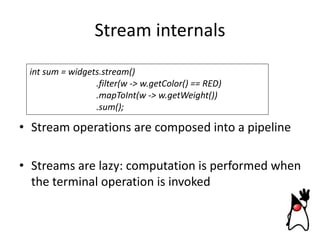


![Method references – instance
methods (1)
public class Document {
public String getPageContent(int pageNumber) {
return this.pages.get(pageNumber).getContent();
}
}
public static void printPages(Document doc, int[]
pageNumbers) {
Arrays.stream(pageNumbers)
.map(doc::getPageContent)
.forEach(Printers::print);
}](https://image.slidesharecdn.com/newfeaturesinjdk8-140227080749-phpapp02/85/New-Features-in-JDK-8-20-320.jpg)








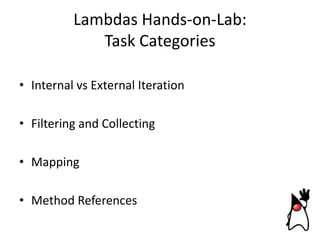


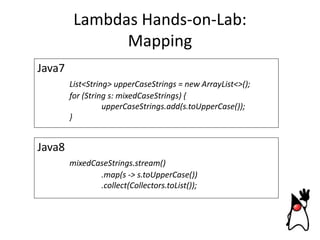
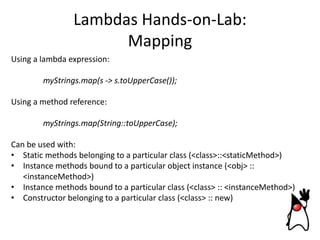







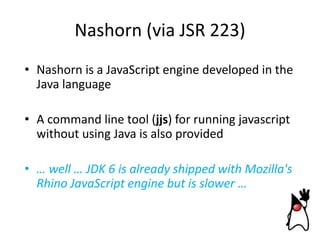


![Parameter Names (JEP 118)
• Parameter names for method/constructor
parameters can be retrieved at runtime via
reflection
Method method = …
Parameter param = method.getParameters()[0];
System.out.println(param.getName());](https://image.slidesharecdn.com/newfeaturesinjdk8-140227080749-phpapp02/85/New-Features-in-JDK-8-44-320.jpg)

